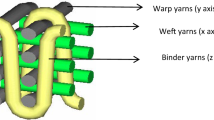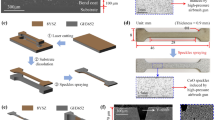Abstract
This study analyses the impact properties of high impact polystyrene (HIPS). HIPS is one of the well-known toughened polymers. The high toughness is given by the rubbery phase. The impact fatigue behavior of HIPS was studied with a Ceast pendulum type tester (Resil 25). The fracture mechanisms were examined with a scanning electron microscopy. The nature of crack initiation and propagation was investigated for small impact angles and three different spans. The impact angles of charpy hammer were chosen as 5°, 10°, 15°, 20°, and 25°. The fracture characteristics varied with the impact angle, the number of impacts, and the distance between supports. The rate of crack propagation was high at higher impact angles with lower endurance, and low at lower impact angles with higher endurance.
















Similar content being viewed by others
References
Ho MH, Hwang JR, Doong JL (1999) Polym Eng Sci 39:708
Perkins WG (1999) Polym Eng Sci 39:2445
Trantina G, Nimmer R (1994) Structural analysis of thermoplastic components. McGraw-Hill, New York, p 241
McCrum NG, Buckley CP, Bucknall CB (1997) Principles of polymer engineering. Oxford Science Publications, New York, p 84
Strong AB (2000) Plastics: material and processing. Prentice Hall, NJ, p 143
Argon AS (1999) J Appl Polym Sci 72:13
Turley SG, Keskkula H (1980) Polymer 21:466
Lee SJ, Jeoung HG, Ahn KH (2003) J Appl Polym Sci 89:3672
Dagli G, Argon AS, Cohen RE (1995) Polymer 36:2173
Rios-Guerrero L, Keskkula H, Paul DR (2000) Polymer 41:5415
Jelcic Z, Holjevac-Grguric T, Rek V (2005) Polym Degrad Stab 90:295
Rek V, Holjevac-Grguric T, Jelcic Z, Hace D (1999) Macromol Symp Polym Charact 148:425
Suresh S (1999) Fatigue of materials; Cambridge solid state science series. Cambridge University Press, Cambridge, UK, p 192
Ray D, Sarkar BK, Bose NR (2002) J Appl Polym Sci 86:1995
Şahin T, Sinmazçelik T, Arici A (2004) J Mater Sci 39:2543. doi:https://doi.org/10.1023/B:JMSC.0000020024.52958.13
Author information
Authors and Affiliations
Corresponding author
Rights and permissions
About this article
Cite this article
Yilmaz, T., Sahin, T. & Sinmazcelik, T. Fracture characteristics of high impact polystyrene under impact fatigue loadings. J Mater Sci 44, 4308–4314 (2009). https://doi.org/10.1007/s10853-009-3640-3
Received:
Accepted:
Published:
Issue Date:
DOI: https://doi.org/10.1007/s10853-009-3640-3




